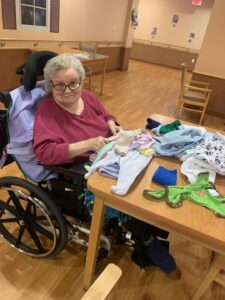Laying the groundwork for a future of emotion-based care
Our personal experiences and stories make us who we are; they define our identities and give our lives meaning and purpose. Unfortunately, as memories slip away for people with dementia, they often feel a loss of identity, which can be distressing.
By focusing on meaningful interactions and engaging surroundings, emotion-based care can help ease this sense of loss, and restore a sense of identity and wellbeing. In collaboration with Meaningful Care Matters, an organization that specializes in emotion-based care, peopleCare Oakcrossing Long-Term Care (LTC) in London, Ontario, is piloting the Butterfly Approach in their 32-bed Juniper special care area for residents with dementia. The approach is a type of emotion-based care, and recognizes the importance of understanding each individual’s emotional needs and preferences to foster that critical sense of self and belonging.

Executive Director Deb Sims and Project Coordinator Butterfly Lead Emily Haskett have a unique way to track the 100+ areas of focus needed to achieve Butterfly accreditation
“It’s really exciting for everyone involved,” says Emily Haskett, Project Coordinator/Butterfly Lead at Oakcrossing LTC. “For the residents, letting them be free to express themselves as they wish is very meaningful for them. Their history makes up who they are as unique and amazing people. Emotion-based care helps support their sense of self and individuality.”
“It’s also amazing for our staff because they get to provide a different type of care,” says Haskett. “They feel empowered to take extra time with the residents. It’s been great to see staff sitting down with residents, holding hands, letting the resident help them with tasks.” For instance, one resident was thrilled when a team member let them help empty a dryer. “They felt like they had something to offer and were contributing to their community.”

Residents in Oakcrossing LTC’s Juniper home area are activated with tasks they choose that are meaningful to them.
While a number of emotion-based care models exist, the Butterfly Approach appealed to peopleCare because of their “Free to Be Me” motto. “We liked the concept of letting the residents do what they want, when and how they want. It gives them more agency,” says Haskett.
Emotion-based care reflects peopleCare’s commitment to honouring each resident’s preferences and personality, delivering flexible, meaningful care. Piloting this approach at Oakcrossing lays the groundwork for eventually expanding emotion-based care across all peopleCare homes, further supporting our vision to change the world of senior living.
Deb Sims, Executive Director at Oakcrossing, sees the Juniper home area as the ideal place to bring this vision to life. “We want this home area to tell the story of our residents’ and families’ lived experiences. For everyone to walk the halls and feel warmth, belonging, independence, joy—the sounds and smells of home, and people enjoying their day-to-day lives. We want to hear staff having meaningful conversations and see them being more than caregivers. We want them to feel like an extended family for the people we serve.”

The relationship between residents and staff is key to emotion-based care.
Since September of this year, 66 Oakcrossing team members have already participated in monthly full-day training sessions. In total, these staff will learn and grow through eight workshops, each focused on a unique topic—from the basics of emotion-based care, to dining room etiquette, to dealing with one’s own emotions in order to be able to provide the best possible care for residents.
“We’ve discussed what we would want if we were living in LTC,” says Haskett. “And we talk deeply about transforming the physical environment.” For example, peopleCare already enhances areas throughout it’s homes with sensory scape murals, and these will continue to be an important component as we adopt of the Butterfly model. Through the training, staff learned that people with dementia see five times less colour than the normal eye and that high colour contrasts in the environment can reduce falls. “The colours in the home may seem very bright to us, but they’re both nice to the residents and important for safety reasons.”
Along with enhancing the surroundings, one big change that will happen over time is staff wearing street clothes instead of uniforms, even wearing pajamas on night shifts. This can help orientate residents to it being nighttime and is reflective of familiar evening routines that would be typical for any family and home.

Staff are wearing pajamas on the night shift in Juniper, which most people associate with familiar routines as the evening winds down at home.
While the program is being introduced in only one area of Oakcrossing LTC at the moment, residents, families and staff report noticeable improvements in the environment and culture, and staff in other parts of the home are eager to participate. Family members have even embraced the butterfly approach as a way to connect with their loved one’s fellow residents. For instance, Juniper residents now have a “word cloud” outside their door that highlights their interests, likes and dislikes. Visitors are using these as conversation starters to connect with residents with whom they aren’t familiar, fostering connection and community.
While Oakcrossing LTC is working towards accreditation in the Butterfly Approach in August of 2025, this pilot is about much more. With the help of team members, the residents and their families, peopleCare is reimagining senior living, creating transforming experiences in vibrant, people-centered communities across Ontario. The learnings and feedback from our experience with the Butterfly Approach will empower us to adapt the program to best serve all of our residents and expand emotion-based care to all of our homes in future.

